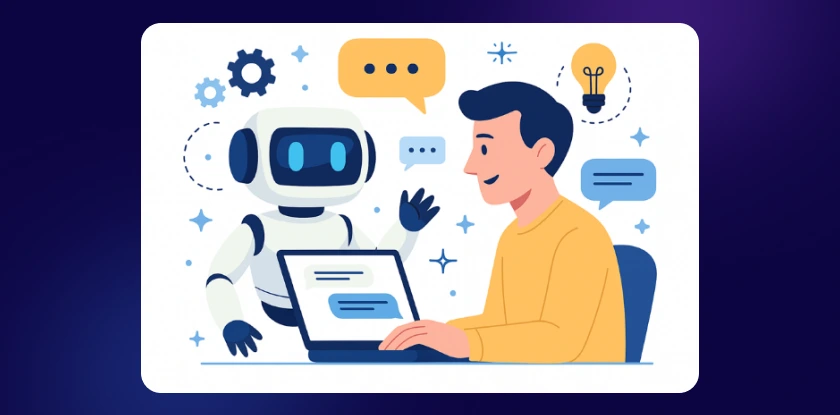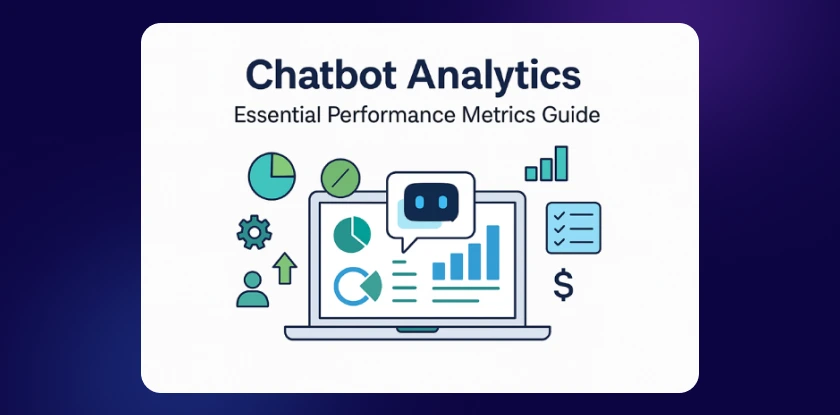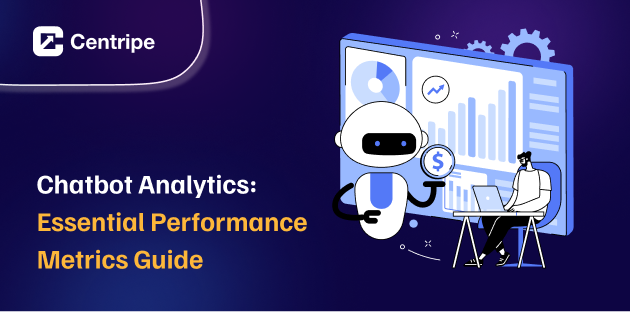Chatbot analytics is rapidly becoming a business fundamental. By 2025, companies could save $11 billion a year and 2.5 billion work hours by using chatbots, according to Exploding Topics.
So, do we need it? Of course. It helps our business grow. AI-Powered Chatbots have become a dominating factor in marketing and sales.
With resources of information, they work on a strategy that works. Bringing in results, that business wants.
Springs Apps reports that chatbots raise sales by 67% and make many industries more efficient.

What are Chatbot Analytics?
Chatbot analytics shows you clear insights into all the conversations your bot has on your site.
You collect, measure, and crucially act on conversational data to boost performance. Without analytics, you’re guessing what works. You can see where customers leave and fix issues before they hurt their experience.
Core Components include:
- Conversational Intelligence
- Intent recognition
- Context handling
- Confidence scoring
- Entity extraction
User Behaviour Patterns include:
- Journey mapping
- Abandonment points
- Peak chat times
- Device preferences
Business Impact Metrics include:
- Leads qualified
- Support tickets avoided
- Resolution speed
- Cost comparison
- Revenue attribution
Sentiment and Satisfaction Indicators include:
- Real-time frustration detection
- CSAT scores
- NPS impact
- Honest feedback forms
Operational Performance encompasses crashes, response lag, handoff smoothness, and true running costs.
How to Measure Chatbot Performance
Performance measurement turns assumptions into proof. It does this by:
- Highlighting common customer questions.
- Finding pain points in conversations.
- Uncovering delights and frustrations.
- Showing different behaviours across customer segments.
A B2B software company found from analytics that 67% of users needed password resets. This wasn’t a complex issue. A quick reset flow reduced support tickets by 23% in two weeks.
The ROI Formula is:
Chatbot ROI = (Cost Savings + Revenue Generated – Total Investment) / Total Investment × 100.
Cost Savings equal human chat cost minus bot cost multiplied by bot chats. Revenue Generated equals qualified leads times conversion rate times average deal size.
Gartner shows that companies using customer service chatbots can cut customer service costs by up to 30%.
Analytics allows for scalable personalisation by grouping users based on their behaviour. It also supports quick and on going improvement.

Explore more articles: How to Use E-commerce Chatbot
Track These 15 Chatbot Performance Metrics
1. Bot Activation Rate
It shows how many visitors begin chatting. To calculate it, divide unique conversations by total visitors, then multiply by 100%.
The target range is 15-25%. Low activation rates often mean chatbots are not positioned well or their opening messages fail to engage visitors.
2. Message Exchange Rate
It shows how deep conversations are. It divides total messages by total conversations. For support, aim for a rate of 5-8.
For lead generation, target 3-5. This metric shows if conversations are too shallow to be useful or too long. Long chats might signal confusion or complexity issues.
3. Engagement Depth Score
It measures users who send 2 or more messages. To calculate it, divide the number of users with 2 or more messages by the total number of users.
Then, multiply the result by 100%. The target range is 35-45%. Higher scores mean users think the chatbot is helpful. They are likely to keep chatting after the first message.
4. Goal Completion Rate (GCR)
Measures success by dividing completed conversations by total conversations and multiplying by 100%. The goal is 60% or higher. This is likely the key metric. It shows if your chatbot is meeting its business goals.
5. Lead Qualification Rate
To find the chat-to-qualified lead conversion rate, take the number of qualified leads and divide it by the total conversations.
Then, multiply the result by 100%. This metric is key for sales chatbots. It affects marketing ROI and the quality of the sales pipeline.
6. Revenue Attribution
It tracks revenue from bot chats. It uses UTM, conversion tracking, and attribution models.
Attribution shows why chatbot investments matter. It also reveals which conversation paths attract the best customers.
7. Containment Rate
To find the percentage of issues the bot solved, divide the bot-only resolutions by the total conversations. Then, multiply by 100%.
The goal is to achieve over 70% for FAQs. High containment rates lower support costs. In contrast, low rates might show knowledge gaps or poor conversation design.
8. Human Handoff Rate
Calculates the percentage of chats that escalated to humans. This is done by dividing escalated chats by total chats and then multiplying by 100%.
The ideal range is 15-30%. If the number is too high, the bot may not manage enough queries. If it’s too low, complex issues might not be escalated properly.
9. Average Resolution Time
Measures conversation duration. It compares bots and humans. The goal is 80% faster resolution.
Faster resolution times improve customer satisfaction while reducing operational costs and agent workload.
10. Intent Recognition Accuracy
Tracks bot understanding rate by dividing correct intents by total intents, then multiplying by 100%.
The goal is to reach 85% or higher. Bad intent recognition causes frustrating user experiences. It also raises handoff rates to human agents.
11. Customer Satisfaction Score (CSAT)
Calculates post-chat user ratings by dividing positive ratings by total ratings. Then, multiply by 100%.
The goal is to achieve 80% or higher. CSAT scores give clear feedback on user experience. They also show where improvements are needed.
12. Sentiment Trend Analysis
Monitors emotional tone shifts through real-time monitoring systems. Tracking sentiment changes shows where users feel frustrated.
This helps find conversation points needing intervention or process improvements.
13. User Retention Rate
Calculate: number of returning users divided by total users multiplied by 100%. High retention rates show that users find the chatbot valuable. They want to return for future chats.
14. Topic Clustering/Trends
Identifies themes in conversations to update resources and information accordingly. Regular analysis shows new customer needs.
It helps us decide which knowledge base updates and new features to focus on.
15. Cost per Automated Interaction
Calculates the cost of bot interactions by dividing total costs by the number of bot chats. This is usually 10-20 times cheaper than using humans.
This metric shows how well automation saves money and helps figure out total support cost savings.
According to Juniper Research, chatbots will save businesses $8 billion annually by 2024.
Want to learn more? Check out this related blog:
Healthcare Chatbot: Transforming Patient Experience and Operations in 2025
Case Study
Company: Eye-oo (multi-brand eyeglasses retailer, Italy)
Challenge: Eye-oo wanted to improve customer engagement and recover lost sales through automation. They were using Shopify Chat but saw an opportunity for better performance.
Solution: In late 2023, Eye-oo switched to live chat, deploying AI chat flows. These flows focused on cart recovery and personalized product recommendations.
Results after one year:
- $238000 increase in revenue, directly attributable to the chatbot upgrade.
- 25% overall sales increase through targeted engagement strategies.
- Lead capture automation: 1,305 leads automatically captured.
- Support efficiency: 82% of 2,233 support inquiries resolved instantly by the chatbot.
- Response time improvement: 86% reduction in first-response time (from 2–5min to about 30sec).
Conclusion
Chatbot analytics is the difference between guesswork and business intelligence.
These 15 metrics will turn your chatbot from a cost centre into a revenue driver. Skip vanity metrics. Focus on clear goals, tracking, and continuous improvement.
The future will offer predictive intelligence, emotion AI, and self-optimising bots. Every conversation will add value to your business.
